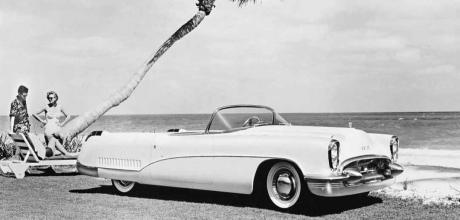Buick Wildcat

You might associate Buick’s Wildcat nameplate with hot-rodded executive saloons, sizzling sedans if you like, but the nameplate originated on something far more radical, as Richard Heseltine discovers…
To label the Buick Wildcat as being obscure is perhaps disingenuous, but it remains underappreciated in concept car lore. While not one of General Motors’ showstopping greats, it wasn’t without influence.
Created under the aegis of styling czar Harley Earl, it was one of a raft of custom-built machines that participated in GM’s travelling Motorama extravaganza in 1953 which kicked off at New York’s Waldorf Astoria in January of that year. It subsequently headed to Chicago, Miami, Los Angeles, San Francisco, Dallas and Kansas City.
The Wildcat was certainly seen by large numbers of people, if nothing else, which was rather the point of the exercise. According to promotional material of the period, this two-seater convertible was a: ‘…trial flight in glassfibre and steel’. It was also billed as being ‘…a prototype of future cars’. In some ways it was, too, not least because the idea of a concept car was still relatively new. The brochure proclaimed: “Buick bypasses time and tradition and brings your dream car closer. Buick’s progressive search for finer styling and better cars for America’s motorists enters a new era with the presentation of the revolutionary new sports convertible – the Wildcat – featuring a glassfibre body.” It went on to add: “Adoption of easily moulded glassfibre for the bodies of Buick experimental models shortens the time between new styling ideas and their incorporation into cars that can be tried and tested. And presentation of these futuristic models for public view – as in the case of the Wildcat – affords an opportunity to ‘pre-test’ the motorists’ reaction to various styling features incorporated in these cars.” Not only that, unlike many other show queens of the period, the Wildcat was no mere ‘push-mobile’ (a term used in styling studios for mock-ups).
Powered by Buick’s then-new 322cu in V8 allied to a Dynaflow automatic transmission, the Wildcat was a driver although, tellingly, no performance figures were released. Standing 1372mm (54 inches) high at the top of its panoramic, 60-degree raked windscreen, one of the more unusual features was a row of 15 vertical slats sunk into the right-side rear wing (but not the left). The reasoning behind this remains unclear. The vestigial tailfins and taillight arrangement, by contrast, was more akin to that found on contemporary Cadillacs. Buick also made a big fuss about the ‘roto-static’ wheel discs which remained stationary while the wheels ‘…revolved around them’.
Like all good concept cars, the Wildcat was tethered in reality. The front end, in particular, foretold 1954 Buick production cars. It’s just that it suffered by comparison with a pair of Motorama stablemates: firstly, there was the Buick XP-300 which was lower, longer and sleeker. It is often cited as having pioneered the use of a wraparound windscreen. Then there was that other glassfibre-bodied confection, the Chevrolet Corvette, which entered series production in 1953. The Wildcat was well-received in period, but it still played third fiddle.
The Wildcat II roadster that arrived a year later was a much more aggressive-looking machine, if perhaps not as attractive. A series of concept cars bearing the name continued to appear thereafter, the first of the line being retrospectively referred to as Wildcat I in certain circles. And while its fame proved fleeting, this one-off escaped the destiny of many of its contemporaries: it wasn’t crushed once it had outlived its usefulness.

